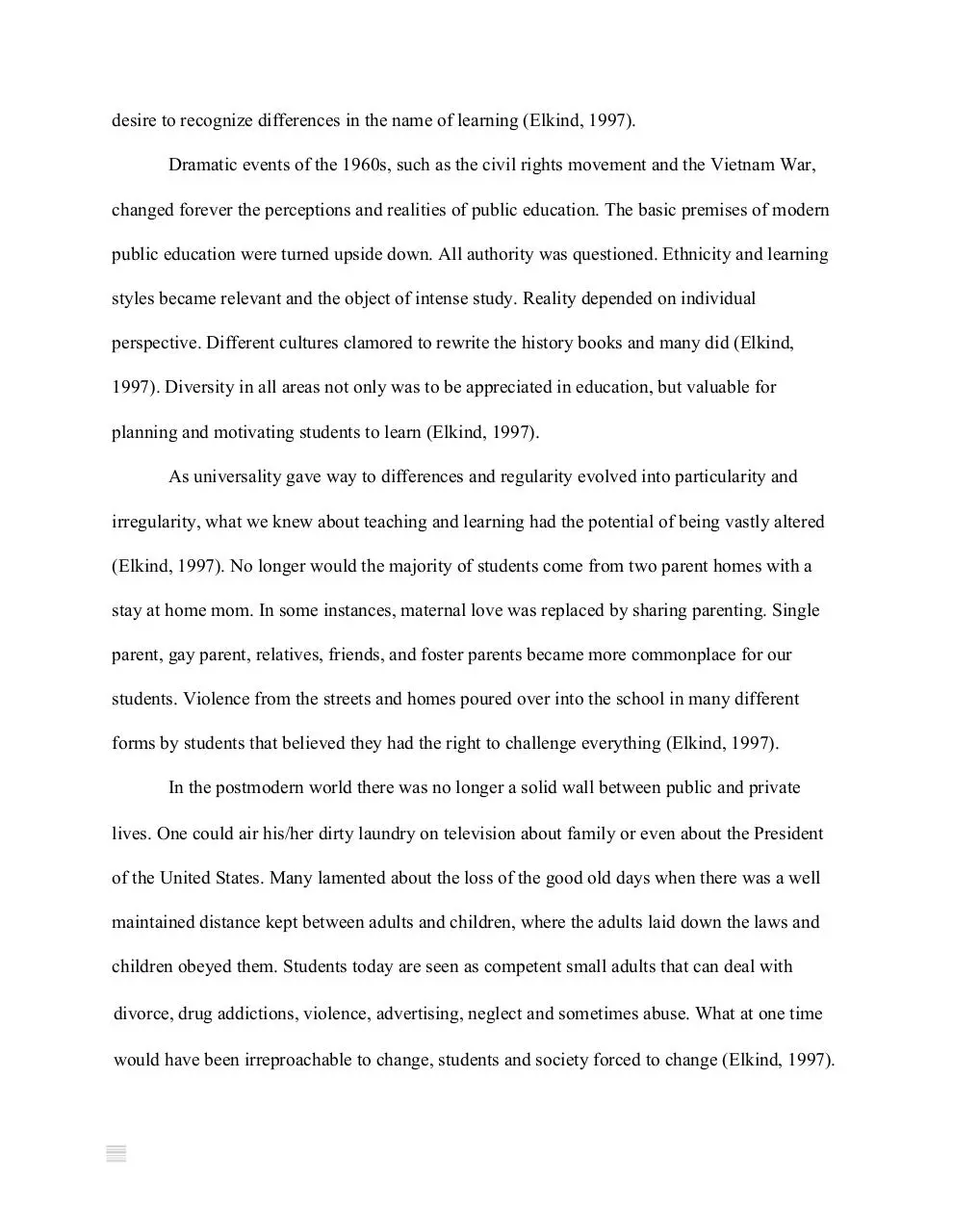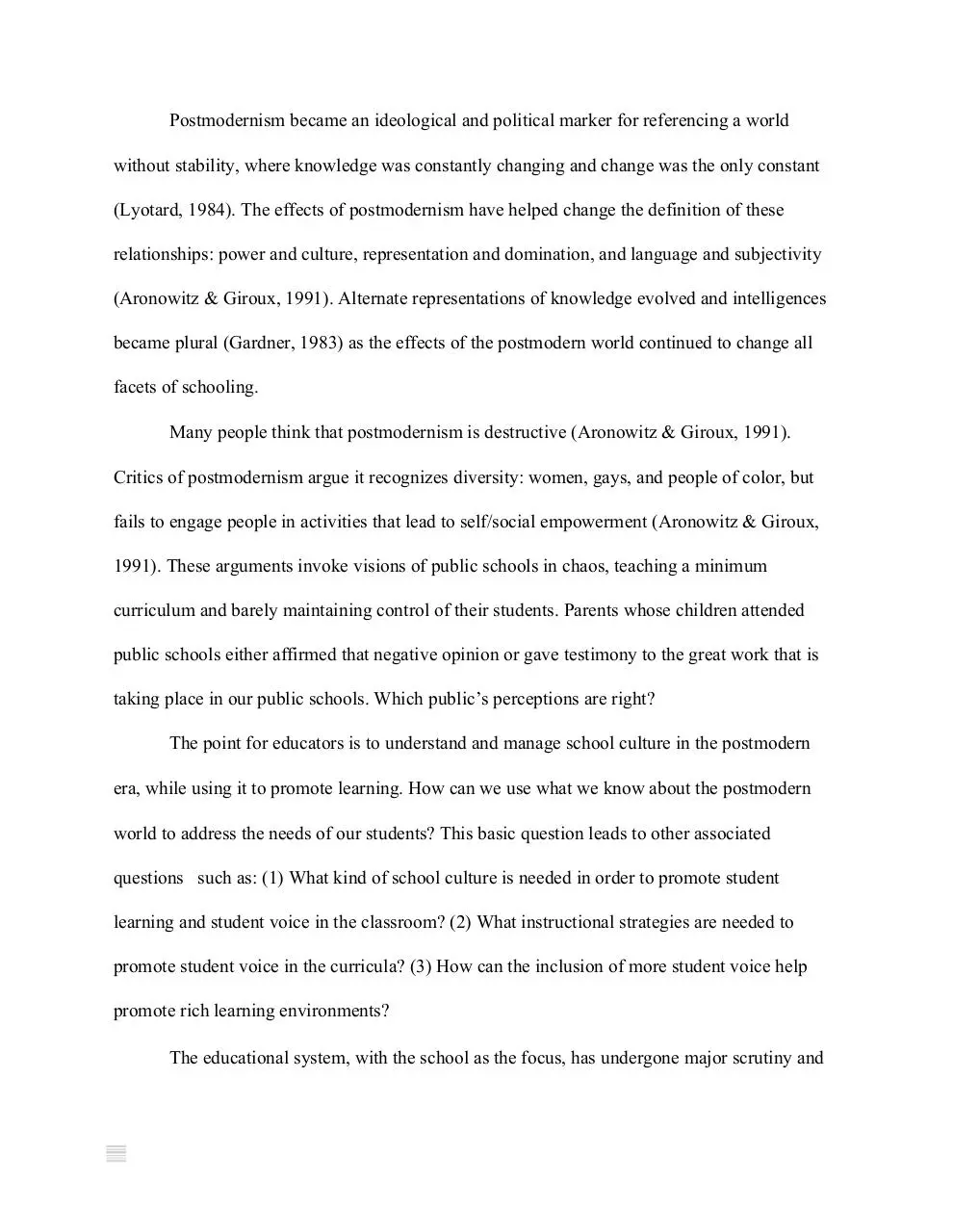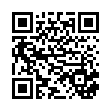pos student voice (PDF)
File information
This PDF 1.5 document has been generated by / Skia/PDF m54, and has been sent on pdf-archive.com on 18/07/2016 at 05:21, from IP address 114.77.x.x.
The current document download page has been viewed 545 times.
File size: 267.51 KB (17 pages).
Privacy: public file





File preview
Positioning Student Voice in the Classroom:
The Postmodern Era
by
Sharon E. Richardson Dissertation
submitted to the Faculty of the
Virginia Polytechnic Institute and State University
in partial fulfillment of the requirements for the degree of
DOCTOR OF EDUCATION
in
Educational Leadership and Policy Studies
APPROVED:
September, 2001
Blacksburg, Virginia Key
words:
Student voice
Postmodernism School
Culture
INTRODUCTION AND REVIEW OF LITERATURE
Postmodernism
Engaging young minds in the postmodern era is a challenging career. Learning and
schooling occurring against a backdrop of societal changes that include enhanced social and
sexual maturity, poverty, neglect and abuse, is a complex, monumental task and the topic of
many people. Being a teacher is tough today, being a student is tougher (Ruddick, Day &
Wallace, 1997). Including the voice of the teacher and the student in today’s classroom to create
a supportive and productive learning environment is one of the most essential challenges
educators struggle with today.
Studying the postmodern era intensely illuminates the differences between it and the
modern era. The modern era, roughly from the Renaissance and Enlightenment to the Second
World War, was ushered in by the philosophical ideas of John Locke (1692/1930), Rousseau
(1911), and by innovative practitioners such as Heinrich Pestalozzi (Greene, 1914) and Friedrich
Froebel (1893). The modern era had three definitive ideas: progress, universality and regularity
(Elkind, 1997).
Universality generally proposed that students were homogeneous in nature both
cognitively and socially and they would all progress at a regular pace utilizing the same
curriculum and resources. Textbooks were the same for all students regardless of difficulty of
text. Textbooks made no attempt to recognize minority children. All children were expected to
identify with the universal AngloAmerican child (Elkind, 1997).
Progress in the school setting came in the form of John Dewey. He brought American
public education fully into the modern era. Dewey argued for a progressive pedagogy where the
student was an active participant. He believed education was for everyone and that education
should follow a predictable sequence in the learning (Elkind, 1997).
Regularity in achievement in school was assumed to follow a normal or regular curve of
probability with most students achieving near the mean and fewer and fewer scoring further
from the norm. Students that didn’t keep up the pace were judged as having some disability or
defect (Elkind, 1997).
Another setting in the modern era that changed and had an effect on the students was
their home. In the home setting divorce was rarely an option and definitely not the norm.
Maternal love was based on the notion that all mothers have an instinctive need to love and care
for their children (Elkind, 1997). It was a basic tenet of the times that the woman’s role was to
care for the children and the house. Students that entered kindergarten found a setting more like
home than school. Teachers were expected to teach and parents were expected to take care of the
discipline. Parents were responsible for teaching values while teachers were responsible for
instruction in the three “R’s.” Elkind (1997) believed, “The shift from modern to postmodern
education reflects changes in the family as well as in the guiding beliefs of the larger society”
(p.28).
After World War II, educators such as Maria Montessori (1964) and Piaget (1965) helped
introduce the postmodern educational tenets of difference, particularity and irregularity to
schools. It is difficult to fully understand the complex organization called school without
understanding the effects postmodernism has had on it. All educational practices came under
scrutiny. Developmentally appropriate practices, cooperative learning, performance assessments
and learning styles are all educational practices that sprang from the changing values of the
postmodern era. Irregular nontests methods of assessments such as portfolios, projects and
performances spoke to the idea that children learn in different ways. Special Education became
the law in recognizing the differences in how students learn. Gifted, learning disabled,
emotionally disturbed and multihandicapped are just a few of the irregular labels created by our
desire to recognize differences in the name of learning (Elkind, 1997).
Dramatic events of the 1960s, such as the civil rights movement and the Vietnam War,
changed forever the perceptions and realities of public education. The basic premises of modern
public education were turned upside down. All authority was questioned. Ethnicity and learning
styles became relevant and the object of intense study. Reality depended on individual
perspective. Different cultures clamored to rewrite the history books and many did (Elkind,
1997). Diversity in all areas not only was to be appreciated in education, but valuable for
planning and motivating students to learn (Elkind, 1997).
As universality gave way to differences and regularity evolved into particularity and
irregularity, what we knew about teaching and learning had the potential of being vastly altered
(Elkind, 1997). No longer would the majority of students come from two parent homes with a
stay at home mom. In some instances, maternal love was replaced by sharing parenting. Single
parent, gay parent, relatives, friends, and foster parents became more commonplace for our
students. Violence from the streets and homes poured over into the school in many different
forms by students that believed they had the right to challenge everything (Elkind, 1997).
In the postmodern world there was no longer a solid wall between public and private
lives. One could air his/her dirty laundry on television about family or even about the President
of the United States. Many lamented about the loss of the good old days when there was a well
maintained distance kept between adults and children, where the adults laid down the laws and
children obeyed them. Students today are seen as competent small adults that can deal with
divorce, drug addictions, violence, advertising, neglect and sometimes abuse. What at one time
would have been irreproachable to change, students and society forced to change (Elkind, 1997).
Postmodernism became an ideological and political marker for referencing a world
without stability, where knowledge was constantly changing and change was the only constant
(Lyotard, 1984). The effects of postmodernism have helped change the definition of these
relationships: power and culture, representation and domination, and language and subjectivity
(Aronowitz & Giroux, 1991). Alternate representations of knowledge evolved and intelligences
became plural (Gardner, 1983) as the effects of the postmodern world continued to change all
facets of schooling.
Many people think that postmodernism is destructive (Aronowitz & Giroux, 1991).
Critics of postmodernism argue it recognizes diversity: women, gays, and people of color, but
fails to engage people in activities that lead to self/social empowerment (Aronowitz & Giroux,
1991). These arguments invoke visions of public schools in chaos, teaching a minimum
curriculum and barely maintaining control of their students. Parents whose children attended
public schools either affirmed that negative opinion or gave testimony to the great work that is
taking place in our public schools. Which public’s perceptions are right?
The point for educators is to understand and manage school culture in the postmodern
era, while using it to promote learning. How can we use what we know about the postmodern
world to address the needs of our students? This basic question leads to other associated
questions such as: (1) What kind of school culture is needed in order to promote student
learning and student voice in the classroom? (2) What instructional strategies are needed to
promote student voice in the curricula? (3) How can the inclusion of more student voice help
promote rich learning environments?
The educational system, with the school as the focus, has undergone major scrutiny and
reforms in the name of improvement. Coming to understand more about the power and
participatory status of students in the classroom can help educators shape their practice in more
responsive ways.
School Culture
Schools, like other organizations, have been shown to have different climates or cultures.
The essence of a group’s culture is its pattern of shared, takenforgranted basic assumptions
that will manifest itself at the levels of observable behaviors (Schein, 1992). Culture is
multifaceted, multidimensional and not easily understood (Schein, 1992). Some even believe
that the schools’ effect on productivity is so powerful that creating a particular kind of school
culture is essential to the effectiveness of the organization (Deal, 1982). Schein (1992) believes
that, “Culture can be analyzed as a phenomenon that surrounds us at all times, being constantly
enacted and created by our interactions with others” (p.1).
With research showing the importance of school culture, trying to create the right kind
becomes essential. School culture has recently emerged as a framework for the study and
interpretation of the structure of schools, especially in facilitating school improvement (Deal,
1991; Greene, 1991).
Studies examine several models for building quality cultures in organizations. The
Education Quality Benchmark System (EQBS) was designed by Snyder, AckerHocevar, and
Wolf (AckerHocevar,1996) into a statewide project in Florida. This action research project
involved the University of South Florida, thirteen school districts and a regional network to
create a support system for change within a framework. The EQBS was based on systems
thinking. Its models, the Quality Performance System Model and the Change Process Model,
provided mental models for restructuring schools (AckerHocevar, 1996).
However, two factors are worth considering when utilizing prescriptive approaches to
building or changing culture. First, relevant literature suggests empirically based knowledge
about culture in organizations is somewhat scarce and spotty. Second, the study of culture has its
deep roots in anthropology and it is difficult to generalize any findings to other cultures, such as
education (Sackman, 1991). The meaning of culture itself is interwoven within context.
Sackman believes that the best approach is a heuristic one, which is an inductive approach of
discovering culture rather than explaining it; however, schools need to do more than discover
culture, they may need to create it to maximize learning.
The role of the leader is important and unique because leaders can create, manage, and
sometimes even destroy culture (Schein, 1992). The school based administrator plays a critical
role in establishing a positive culture and managing the anxiety that goes with it. School leaders
have a daunting task of explaining public education today. School leaders must also pay
attention to the external and internal issues of their organizations in to promote a certain culture.
A leader must put things in context and make sense out of them for the organization (Schein,
1992).
To meet an organization’s external goals, internal issues must be handled productively.
Six major internal issues that must be handled effectively to meet external goals in building or
maintaining culture are as follows: creating a common language and conceptual categories,
defining group boundaries and criteria for inclusion and exclusion, distributing power and status,
developing norms of intimacy, friendship and love, defining and allocating rewards and
punishments and explaining the unexplainableideology/religion (Schein, 1992).
Student voice could be present or absent in all six internal issues with some effect;
however, for the purposes of this inquiry student voice finds its path through the school’s
culture, through the internal issue of distribution of power and status. What is the status of
students today with respect to student voice? How are instructional decisions made? What
opportunities exist for people, including students, to have a voice? In what facets of schooling
and learning do students exercise control? How do instructional strategies involve the students
and promote their voice?
The multifaceted complexity of the school organization and the innate individuality of
every child provide many stories that need to be told from different perspectives. A postmodern
voice has been given to all and that finally includes the students. Cultural understanding and
cultural learning start with selfinsight (Schein, 1992). Selfinsight begins with each child’s
voice.
Student Voice: Exploring the Definition
What is student voice? The first definitions studied by educators and researchers were of
a rather practical nature. Student voice is any activity in which students exercise any degree of
control or communicate their feelings (Johnson, 1991). Most educators associate voice with
empowerment which meant students would be given input into any decision affecting them.
Creation of school councils or appointment of students to a sitebased management council
addressed this condition. The student councils, like sitebased management councils, could
spend their time voting on school colors or trying to get the adults to play music in the
lunchroom.
Student councils and representation on management councils have benefits, but do they reach
the maximum number of students on a daily basis and do they affect student learning? The topic
of student voice is broad. In this inquiry it will be limited to instruction.
The curriculum is pervasive and an excellent vehicle to hear more student voices than a
student council. Curriculum,in particular the constructivist views and the use of discourse, have
certainly engaged students more in learning, which is the purpose of schooling (Moore, 1996). A
questioning approach set in a student’s social context is consistent with Dewey’s
recommendation that reallife problems should be at the heart of education (Dewey, 1938). We
mustn’t glamorize student voice but always examine these experiences within larger frameworks
of morality, equity, and the formation of knowledge and culture (Schor, 1986).
Students will resist any process that disempowers them (Schor, 1986). Voice exists
regardless of opportunities and students can tune out at any time. Teachers can quickly silence
students’ voices. A negative comment to a wrong answer can silence a student for years in the
classroom; conversely, a risktaking, thoughtful democratic classrooms can foster students’ self
esteem and motivate students to success.
According to O’Loughlin (1995), students “are storied human beings interpreting their
lives through their ethnicity, gender, class and culture” (p. 110). They live their lives as
narratives that reflect their upbringing. “Rather than possessing one voice, students construct
multiple perspectives on their emerging identities as a result of the social and economic
communities” (p.111). Bakhtin (1986) refers to voice as your “speaking personality or
consciousness” (p. 434).
Voice is not just simply talking or participating in a prescriptive critical thinking
exercise.
Student voice is a much deeper part of an individual (Dahl, 1995). “Voice is as distinctive as a
Download pos student voice
pos student voice.pdf (PDF, 267.51 KB)
Download PDF
Share this file on social networks
Link to this page
Permanent link
Use the permanent link to the download page to share your document on Facebook, Twitter, LinkedIn, or directly with a contact by e-Mail, Messenger, Whatsapp, Line..
Short link
Use the short link to share your document on Twitter or by text message (SMS)
HTML Code
Copy the following HTML code to share your document on a Website or Blog
QR Code to this page

This file has been shared publicly by a user of PDF Archive.
Document ID: 0000401198.